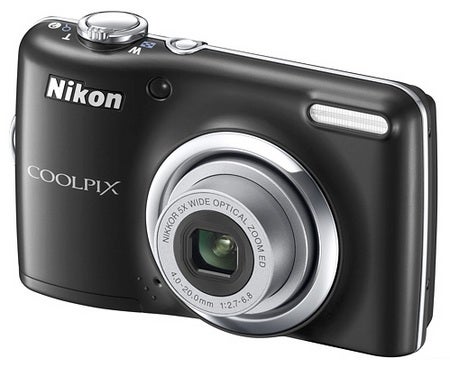Nikon L23 review: A respected brand, a simple design and an attractive price tag. But does the L23 make the grade?
Nikon Coolpix L23 Review
Nikon describes its Coolpix L23 as ‘the perfect camera for anyone just starting out in photography’, and with a host of automated technologies and a fuss-free design we have the say the L23 certainly gets off to a good start.
The Nikon Coolpix L23’s 10MP CCD sensor may seem a little behind the times on paper, but for most purposes it should suffice, while the 5x optical zoom lens is more than respectable for such a modestly priced camera, particularly as it starts from a 28mm wideangle.
Elsewhere, the L23’s Smart Portrait system combines Blink Detection, Skin Softening, Face-Priority AF and Red Eye Fix among other features to help better capture and process portraits, while exposure control comes through Auto and Easy Auto modes, as well as 17 separate scene presets. Blurry images, meanwhile, are tackled in three separate ways, with Motion Detection and Electronic Vibration Reduction, as well as through a Best Shot Selector option that captures 10 images before picking the best.
With no viewfinder, images are composed and displayed solely on the L23’s 2.7in LCD screen, which offers a basic 230k-dot resolution. A mini USB port is situated to the side of the camera for transferring images and videos, while a compartment for two AA batteries and an SD-format memory card is accessed from underneath.
As with many cameras which run on AA batteries, the bulge to Coolpix L23’s side makes for a comfortable grip, while the large shutter release button and adequate thumb-space on the rear mean that it can be held securely with just one hand. Although there’s no help facility of any sort to guide the inexperienced through the camera’s different options, most functions are clearly marked throughout the menu system, and handy previews of different white balance and colour options should at least help those undecided on whether they need to be adjusted or not.
Powering up the Nikon L23 takes just over a second or so, with powering down being just a shade faster. While the speed of zooming through the lens’s range may be a little too fast for some, the zoom collar around the shutter release button does responds well to gentle nudging. Both zooming and focusing are accompanied by a slight whirring sound, but the L23 is by no means the worst offended here; realistically, this should only be a problem in the quietest of environments.
The Nikon Coolpix L23 has an AF assist light springs into action when required, but the single AF point in the centre of the frame is a little limiting should you want to get more creative with focus. The upshot of this, however, is that as the camera will only focus in one place it can do so promptly in a range of situations – even when faced with a low-contrast subjects.
Image quality varies, but overall there’s little to get too excited about. The Coolpix L23 follows its L21 and L22 predecessors in producing heavily-processed images, with plenty of coarse noise on all sensitivities and oversharpening which increases the visibility of jaggies around edge details. Even in good conditions images are often plagued by these kinds of issues, particularly shadow areas which tend to be compromised by noise patterning. For the target market these issues may not be too great a problem, as the expectations will simply be for well-exposed images with a reasonable level of accuracy. Point-and-shoot snapping that’s not for critical work means the L23 will be fine for snapping pictures of friends and family. And the good news is that, aside from a few overexposure issues, the metering system generally gets things right, and white balance also doesn’t do too badly (even under artificial light), although the occasional colder cast is visible in images. Quite whether the expected user for such a camera will use the preset manual white balance option is debatable, but its implementation is surprisingly excellent. Many images taken with flash also retain a pleasing neutrality, which is so often lost with other budget compacts, and distortion from the lens at wideangle is noticeable but not particularly problematic in images.
Verdict
The Nikon L23 has plenty going for it. The large buttons, low price tag, simple operation and comfortable handing make it ideal for first-time users. It's a shame, therefore, that image quality is generally quite poor and not suitable for critical use - but, considering its £70 price tag, it's hit the nail on the head for the budget end of the compact market.





